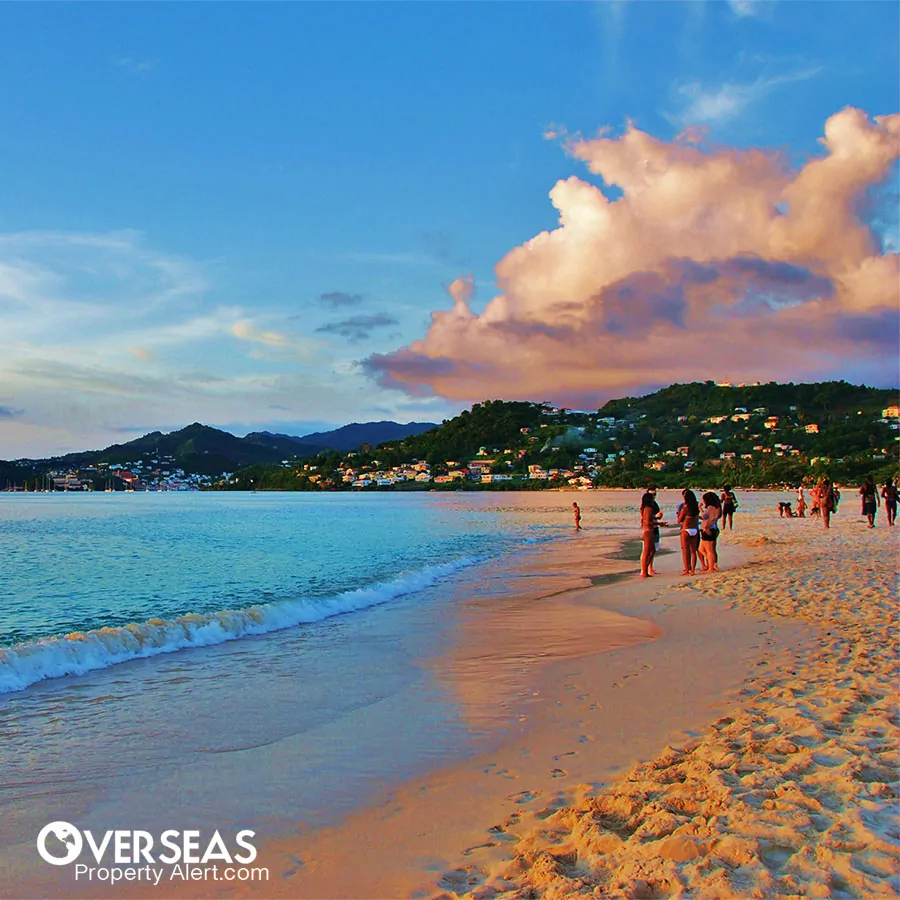You want to find a place to retire or own a second home. Somewhere warm. Somewhere where English is the primary language and where coconut palm trees are abundant. And importantly, a place where the properties are reasonable.
If all this sounds inviting, then the idyllic island nation of Grenada should be at the top of your list. In addition to its dramatic natural beauty, its climate is just about perfect, with average high temperatures ranging from 75° to 87° (24°C to 30°C).
This Eastern Caribbean island gained independence from Great Britain in 1973, and after an invasion and short war with the United States in 1983, the democratic government and political system have been stable. Grenada (pronounced gren-AY-dah) is known as the Island of Spice because of the abundance of spices grown there… especially nutmeg.
Grenada’s beautiful tropical mountains, flowing waterfalls, and uncrowded beaches are what postcards are made of. And its waters offer some of the world’s best snorkeling, diving, and sailing… the latter thanks to the steady trade winds.
What is the drawback? It is not as close as some of the other islands due to its southern location in the Eastern Caribbean, only 100 miles north of Venezuela. Nonstop flights, however, are offered from Miami, New York, Atlanta, Toronto, London, Frankfurt, Caracas, and other Caribbean islands.
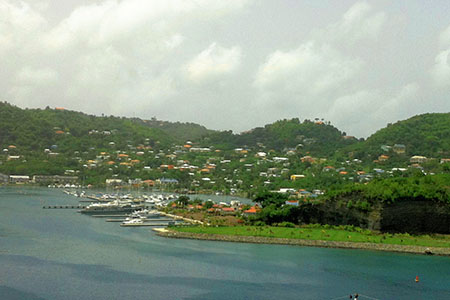 |
| For natural beauty and reasonable properties, the island nation of Grenada should rank high on your list |
Grenada is not a buy-and-sell property market, and properties move slowly on the island. Even if you buy land and build, you may not end up with a quick profit. Part of the reason is the tax regime. The government has established a tax specifically for non-citizens of Grenada, referred to as aliens. All home purchases are charged a 5% fee for an Alien Land Holder License and a 1% stamp duty tax. When/if you sell, non-citizens are charged a 15% tax, unless you’ve obtained Grenadian citizenship in the meantime. (I’ll have more on this in my next article.)
This tax is considered good here for two reasons. First, the tax is the means by which you can own land in Grenada without being a resident or citizen. (It’s the equivalent of the Laudêmio tax for seaside properties in Brazil, which is also 5%.) Second, this tax regime discourages property speculation, resulting in a stable property market over the long-term. When compared to other surrounding islands, this tax regime is seen as a positive.
One big advantage that Grenada has over other Caribbean countries is safety. The crime rate in Grenada is extremely low. Grenadians take a lot of pride in their country. Despite the high unemployment rate, Grenadians want to work… and work hard. Having a caretaker or housekeeper is very affordable.
The Property Market In Grenada
Prices in Grenada are good right now, especially given the intrinsic beauty and high quality of life. The recession is still having an effect on home sales, and land is less expensive than it was nine years ago.
Remember that materials cost more on the island and can take three to four weeks to ship in… so buying an existing home is the way to go at the moment, rather than building.
The price, of course, will depend on what you are looking for. Do you want to be near the beach or in the mountains? What do you require in views or finishes? The swanky LaLuna Resort offers cliff-side villas starting at US$4.25 million dollars. What do you get? Unbelievable ocean views of sailboats floating by, access to the resort, and, of course, a beautifully furnished home approximately 10 minutes from the Maurice Bishop International Airport.
On the other hand, you can buy a small, local home away from the water for less than US$60,000.
There are many lovely, fully furnished, well-maintained homes that are available ranging from US$200,000 to US$500,000… some complete with your very own mango tree in the front yard.
Here are a few examples of homes I found on the market today…
The first condo is huge for a one-bedroom unit at 104 square meters (1,124 square feet), with one full bedroom, one bath, and amazing ocean views overlooking a long, scenic cove. The asking price on this one is US$340,000. Have a look at its beach view in the photo below…
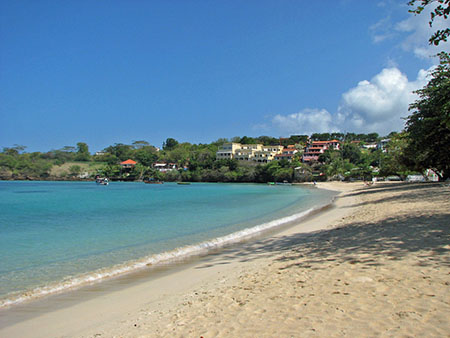 |
| This condo looks out over one of Grenada’s most-scenic beaches |
If you’d rather have a larger, single-family home, this one has three bedrooms and two baths and an impressive 260 square meters (2,800 square feet). The house has ocean views (although somewhat distant), as well as green mountain views. The asking price is US$243,000.
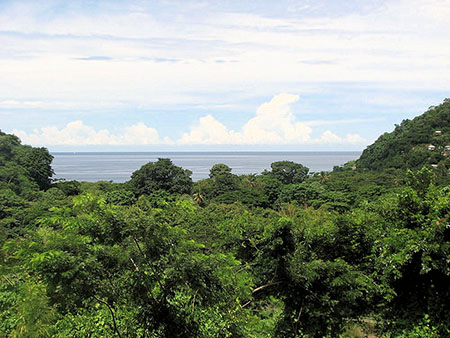 |
| Grenada offers lush, green scenery with lots of ocean views |
For a bit more luxury, have a look at this three-bedroom, two-bath home with its sparkling pool overlooking a tree-lined, scenic cove. The asking price is US$450,000.
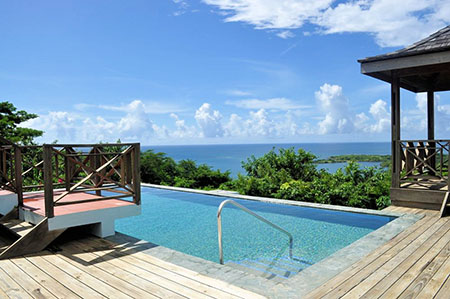 |
| Here you can combine a sparkling pool with a picturesque cove |
My friend Peter Wallace is my preferred real estate contact in Grenada. He lives here and loves it. Peter is an architect who now works with Coldwell Banker and has been on the island for 12 years.
To get more information about Grenada real estate, you can write to Peter here.
There’s a fair-sized expat community in Grenada, and the most popular expat area is the capital city of Saint George’s. If you ask them why they have moved here, the consensus is the tropical climate, the dramatic scenery, and the quality of life. The roads may be potholed, but expats love the simple lifestyle.
And while there is an expat community, Grenada is still relatively untouched in terms of expat retirement.
Granada’s sunshine beckons, and its ocean and waterfalls mesmerize. Come get to know the country as I have over the past month. You can rent a decent beach apartment from US$600 to US$1,000 monthly.
Come to visit Grand Anse Beach, the perfect uncrowded Caribbean beach, where US$2 will buy you an ice cold Carib beer and a view of the ocean sitting beyond the swaying palms and sand. Or for something more substantial, have an elegant meal at The Edge…
You will wonder why you’ve never considered Grenada before.
Miranda Allfrey
For Overseas Property Alert
Hi Lee,
I’ve seen many investment opportunities I would love to be able to participate in but have very limited funds to invest.
Do you ever come across opportunities needing a minimum amount of US$5,000 or less?
I wouldn’t feel comfortable risking anything more but would not be averse to reinvesting any profits for a time.
Thank you,
Tanya
I can’t think of a property investment for under US$5,000, but I can think of one way to make an overseas investment… foreign banking.
For example, you could open an account with Alianza Valores in Colombia. You’d get interest on the account, and you’d also have diversified outside the U.S. dollar. For more info on their products, contact Angela Sanchez. I’ve got several accounts there myself.
I can also recommend Banco de la República, in Uruguay. They offer high-interest-bearing Certificates of Deposit in Uruguayan pesos, with low deposit requirements of 5,000 pesos (about US$166). A two-year note will get you 10% today.
In both cases, if the dollar weakens from today’s high levels, you’ll also profit from the exchange rate.
Hi Lee,
If you will remember, upon your recommendation I got Marjorie White to find me the perfect apartment in Medellín.
Thank you for your help and inspiration along the way!
Brett
[Editor’s Note: The fideicomiso, mentioned below, is a trust. It’s one vehicle that can be used by foreigners to own coastal property in Mexico.]
Hello Lee,
I am just about to purchase a property in the Rivera Maya, and I am still not overly comfortable with the fideicomiso.
I know that it is renewable, but it seems like they can change that at any time. I know you just bought in Mexico so I was wondering how you became comfortable with this process.
Thanks,
Dave
I’m sympathetic to this question, since I was uneasy about this myself. In fact, I contacted a colleague looking for the same kind of reassurance Dave is seeking.
Originally, my reasons for “comfort” were based on the fact that hundreds of thousands of people already own land this way… and the fact that the process is internationally recognized and guaranteed by law.
But frankly, it wasn’t all that comforting… especially given the fact that we’re threatening to build a wall on the border and to deport millions of Mexicans—things that don’t exactly reward Mexico’s current welcoming attitude towards Americans.
In the end, I decided to look at it in a positive and practical way:
- This financial structure has been in use since the Roman times and a part of Mexican Law since the 1920s…
- The fideicomiso protects your asset in the same way that trusts do in our own country…
- It also allows you to leave the property to whoever you want in the event of your death… something that would be difficult and time consuming without the trust…
- In addition to flexibility with your heirs, the trust sidesteps probate… allowing your heirs to take possession right away…
So this trust has advantages… and I think it’s very unlikely that Mexico would violate the terms of existing trusts for so many foreign property owners.
Lee,
I am a big fan of your newsletter! And I have a lot of interest in residency.
Looking at last week’s article on Peru, you said that one could use their US$30,000 investment for property purchase to qualify for the investor visa. However everything I have heard is that that visa is complicated and you need to show a business plan of hiring five people. The link you provide (in Spanish) also states this.
Do you have some new info or a way around this? This would be welcomed news!
Thank you!
Ryan
Ryan is correct, and unfortunately, I don’t personally know a legal way around this.
However a good Peruvian immigration attorney may be able to help.
For the investors’ visa, you must show a plan to create five Peruvian jobs. I appreciate Ryan pointing out this important caveat.
The best option for most of us would be the rentista visa, which requires an income of US$1,000 per month.
Have a question? You can write to Lee here.

